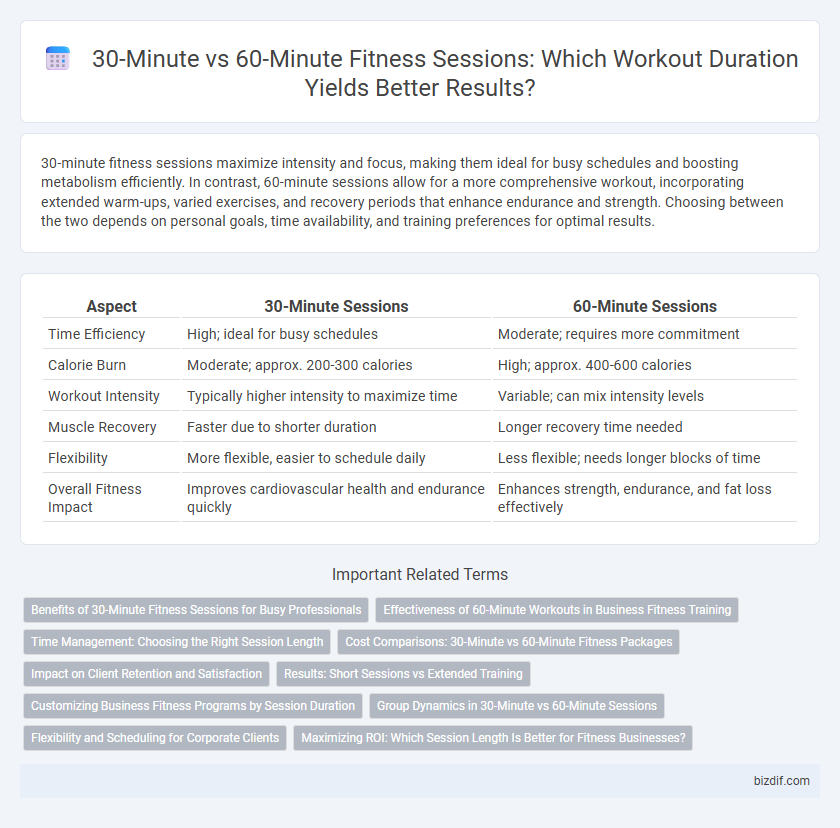30-minute fitness sessions maximize intensity and focus, making them ideal for busy schedules and boosting metabolism efficiently. In contrast, 60-minute sessions allow for a more comprehensive workout, incorporating extended warm-ups, varied exercises, and recovery periods that enhance endurance and strength. Choosing between the two depends on personal goals, time availability, and training preferences for optimal results.
Table of Comparison
| Aspect | 30-Minute Sessions | 60-Minute Sessions |
|---|---|---|
| Time Efficiency | High; ideal for busy schedules | Moderate; requires more commitment |
| Calorie Burn | Moderate; approx. 200-300 calories | High; approx. 400-600 calories |
| Workout Intensity | Typically higher intensity to maximize time | Variable; can mix intensity levels |
| Muscle Recovery | Faster due to shorter duration | Longer recovery time needed |
| Flexibility | More flexible, easier to schedule daily | Less flexible; needs longer blocks of time |
| Overall Fitness Impact | Improves cardiovascular health and endurance quickly | Enhances strength, endurance, and fat loss effectively |
Benefits of 30-Minute Fitness Sessions for Busy Professionals
Thirty-minute fitness sessions offer a time-efficient way for busy professionals to enhance cardiovascular health, improve muscle tone, and boost energy levels without disrupting tight schedules. Research shows that high-intensity interval training (HIIT) and circuit workouts during shorter sessions can burn comparable calories and increase metabolic rate similar to longer workouts. Consistent 30-minute workouts also reduce stress and improve mental clarity, supporting overall productivity and work-life balance.
Effectiveness of 60-Minute Workouts in Business Fitness Training
Sixty-minute fitness training sessions offer superior effectiveness in business fitness programs by allowing comprehensive warm-ups, strength conditioning, and cooldowns, optimizing overall muscle engagement and injury prevention. Extended workout durations enable detailed technique coaching and personalized adjustments, enhancing participant performance and motivation. This thorough approach supports sustained fitness improvements, reduces absenteeism, and boosts workplace productivity.
Time Management: Choosing the Right Session Length
Choosing between 30-minute and 60-minute fitness sessions depends on individual time management and workout goals. Shorter 30-minute sessions offer efficient, high-intensity workouts ideal for busy schedules, maximizing calorie burn and muscle engagement in limited time. Longer 60-minute sessions allow for a comprehensive routine, including warm-up, strength training, cardio, and flexibility exercises, which supports endurance building and detailed skill development.
Cost Comparisons: 30-Minute vs 60-Minute Fitness Packages
30-minute fitness sessions typically cost 40-60% less than 60-minute sessions, making them a budget-friendly option for individuals seeking effective workouts within limited time frames. Purchasing packages for 30-minute sessions often provides greater frequency at a lower overall price, ideal for maintaining consistency without overspending. In contrast, 60-minute packages offer extended training benefits but come with higher per-session costs, requiring a larger financial commitment for long-term fitness goals.
Impact on Client Retention and Satisfaction
30-minute fitness training sessions often enhance client retention by offering time-efficient workouts that fit busy schedules, increasing consistent attendance rates. In contrast, 60-minute sessions may deliver more comprehensive workouts, potentially boosting satisfaction for clients seeking in-depth training but can lead to higher dropout rates due to time constraints. Balancing session length with client goals and lifestyle preferences is crucial for maximizing both retention and satisfaction in fitness programs.
Results: Short Sessions vs Extended Training
Thirty-minute fitness sessions can effectively enhance strength and boost metabolism by concentrating on high-intensity interval training (HIIT), which maximizes calorie burn in a shorter time frame. Sixty-minute workouts offer extended endurance building and comprehensive muscle engagement, promoting greater overall fitness gains and recovery. Selecting session length depends on individual goals, with shorter sessions ideal for fat loss efficiency and longer sessions benefiting muscle growth and stamina.
Customizing Business Fitness Programs by Session Duration
Customizing business fitness programs by session duration enhances employee engagement and maximizes results. Thirty-minute sessions offer efficient, high-intensity workouts ideal for busy schedules, while 60-minute sessions provide comprehensive training with deeper technique focus and recovery time. Tailoring session length to workforce needs and goals increases program adherence and overall health benefits.
Group Dynamics in 30-Minute vs 60-Minute Sessions
Group dynamics in 30-minute fitness sessions foster high energy and rapid motivation through quick, focused interactions that keep participants engaged and accountable. In 60-minute sessions, group cohesion builds more deeply with extended collaboration, allowing for complex routines and social bonding that enhance collective commitment. Shorter sessions optimize intensity and momentum, while longer sessions emphasize teamwork and sustained encouragement within the fitness group.
Flexibility and Scheduling for Corporate Clients
Corporate clients benefit from 30-minute fitness training sessions that improve flexibility while fitting seamlessly into busy schedules, promoting consistent participation and reduced time away from work. In contrast, 60-minute sessions allow for more comprehensive flexibility routines and targeted muscle group work, ideal for clients seeking deeper mobility improvements. Balancing session length with corporate time constraints enhances overall employee wellness and productivity.
Maximizing ROI: Which Session Length Is Better for Fitness Businesses?
30-minute fitness sessions offer higher client turnover and increased scheduling flexibility, leading to greater revenue potential per hour for fitness businesses. In contrast, 60-minute sessions provide deeper engagement and comprehensive training, attracting clients seeking personalized, in-depth workouts. Maximizing ROI depends on balancing session length with client preferences, operational costs, and market demand to optimize both profitability and client satisfaction.
30-Minute Sessions vs 60-Minute Sessions Infographic

 bizdif.com
bizdif.com